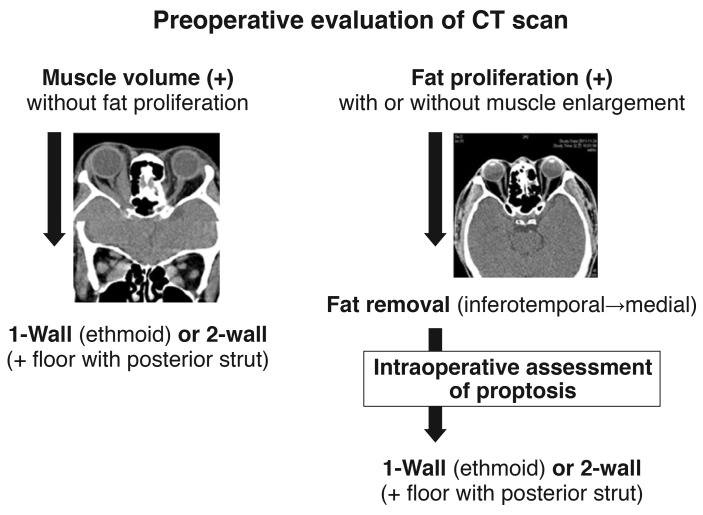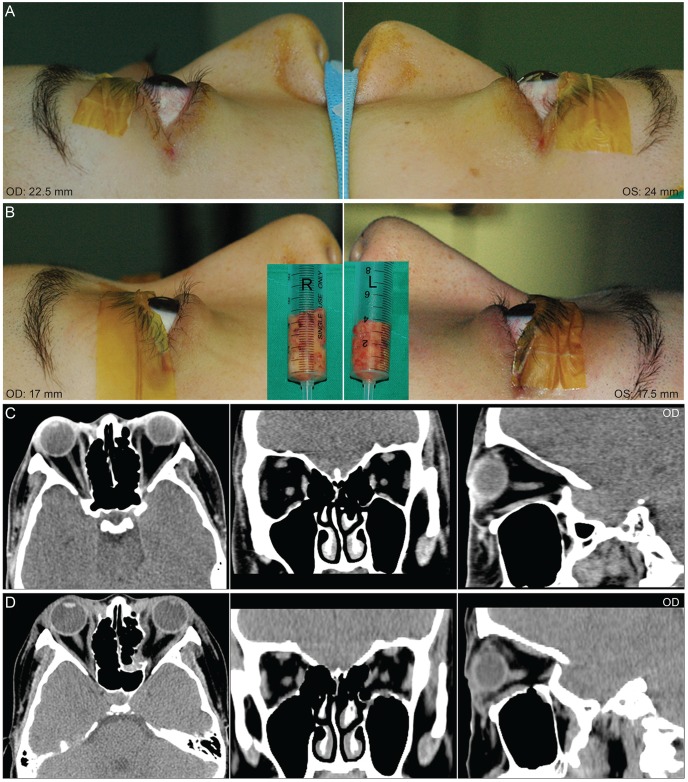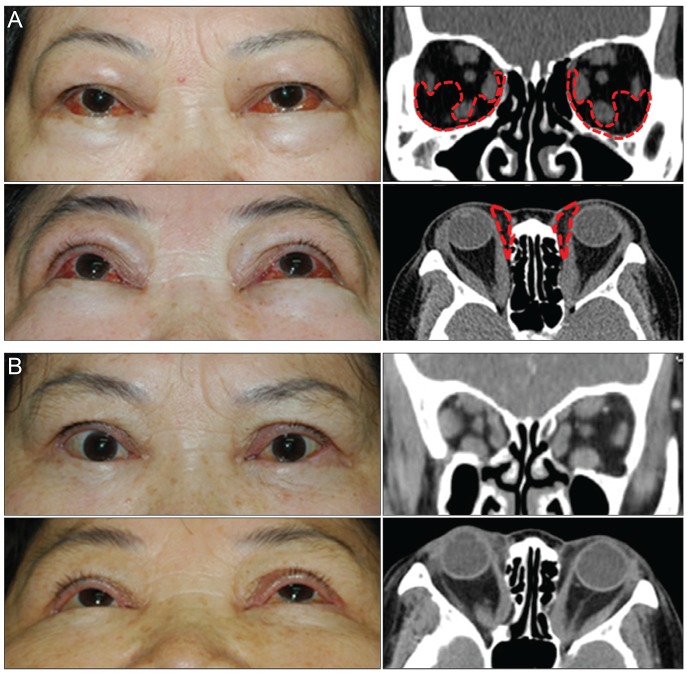1. Lim JI, Bressler NM, Marsh MJ, Bressler SB. Laser treatment of choroidal neovascularization in patients with angioid streaks.
Am J Ophthalmol 1993;116:414-423.


2. Wiegand TW, Rogers AH, McCabe F, et al. Intravitreal bevacizumab (Avastin) treatment of choroidal neovascularisation in patients with angioid streaks.
Br J Ophthalmol 2009;93:47-51.


3. Menchini U, Virgili G, Introini U, et al. Outcome of choroidal neovascularization in angioid streaks after photodynamic therapy.
Retina 2004;24:763-771.


4. Bartalena L, Pinchera A, Marcocci C. Management of Graves' ophthalmopathy: reality and perspectives.
Endocr Rev 2000;21:168-199.


5. Lyons CJ, Rootman J. Orbital decompression for disfiguring exophthalmos in thyroid orbitopathy.
Ophthalmology 1994;101:223-230.


6. Garrity JA, Fatourechi V, Bergstralh EJ, et al. Results of transantral orbital decompression in 428 patients with severe Graves' ophthalmopathy.
Am J Ophthalmol 1993;116:533-547.


7. Leone CR Jr, Piest KL, Newman RJ. Medial and lateral wall decompression for thyroid ophthalmopathy.
Am J Ophthalmol 1989;108:160-166.


8. Goh MS, McNab AA. Orbital decompression in Graves' orbitopathy: efficacy and safety.
Intern Med J 2005;35:586-591.


9. Kikkawa DO, Pornpanich K, Cruz RC Jr, et al. Graded orbital decompression based on severity of proptosis.
Ophthalmology 2002;109:1219-1224.


10. Horn JD. Status of toric intraocular lenses.
Curr Opin Ophthalmol 2007;18:58-61.


11. Kacker A, Kazim M, Murphy M, et al. "Balanced" orbital decompression for severe Graves' orbitopathy: technique with treatment algorithm.
Otolaryngol Head Neck Surg 2003;128:228-235.


12. Bailey KL, Tower RN, Dailey RA. Customized, single-incision, three-wall orbital decompression.
Ophthal Plast Reconstr Surg 2005;21:1-9.


13. Baldeschi L, MacAndie K, Hintschich C, et al. The removal of the deep lateral wall in orbital decompression: its contribution to exophthalmos reduction and influence on consecutive diplopia.
Am J Ophthalmol 2005;140:642-647.


14. Chiarelli AG, De Min V, Saetti R, et al. Surgical management of thyroid orbitopathy.
J Plast Reconstr Aesthet Surg 2010;63:240-246.


15. Trokel S, Kazim M, Moore S. Orbital fat removal. Decompression for Graves orbitopathy.
Ophthalmology 1993;100:674-682.


16. Unal M, Leri F, Konuk O, Hasanreisoglu B. Balanced orbital decompression combined with fat removal in Graves ophthalmopathy: do we really need to remove the third wall?
Ophthal Plast Reconstr Surg 2003;19:112-118.


17. Alsuhaibani AH, Carter KD, Policeni B, Nerad JA. Orbital volume and eye position changes after balanced orbital decompression.
Ophthal Plast Reconstr Surg 2011;27:158-163.


18. Kulwin DR, Cotton RT, Kersten RC. Combined approach to orbital decompression.
Otolaryngol Clin North Am 1990;23:381-390.


19. Elisevich K, Allen L, Bite U, Colcleugh R. Decompression for dysthyroid ophthalmopathy via the orbital rim approach. Technical note.
J Neurosurg 1994;80:580-583.


20. McCord CD Jr. Current trends in orbital decompression.
Ophthalmology 1985;92:21-33.


21. Tallstedt L, Papatziamos G, Lundblad L, Anggard A. Results of transantral orbital decompression in patients with thyroid-associated ophthalmopathy.
Acta Ophthalmol Scand 2000;78:206-210.


22. Stanley RJ, McCaffrey TV, Offord KP, DeSanto LW. Superior and transantral orbital decompression procedures. Effects on increased intraorbital pressure and orbital dynamics.
Arch Otolaryngol Head Neck Surg 1989;115:369-373.


23. Kalmann R, Mourits MP, van der Pol JP, Koornneef L. Coronal approach for rehabilitative orbital decompression in Graves' ophthalmopathy.
Br J Ophthalmol 1997;81:41-45.



24. Liao SL, Huang SW. Correlation of retrobulbar volume change with resected orbital fat volume and proptosis reduction after fatty decompression for Graves ophthalmopathy.
Am J Ophthalmol 2011;151:465-469.


25. Alsuhaibani AH, Carter KD, Policeni B, Nerad JA. Effect of orbital bony decompression for Graves' orbitopathy on the volume of extraocular muscles.
Br J Ophthalmol 2011;95:1255-1258.


26. Alper MG. Pioneers in the history of orbital decompression for Graves' ophthalmopathy RU Kroenlein (1847-1910), O. Hirsch (1877-1965) and H.C. Naffziger (1884-1961).
Doc Ophthalmol 1995;89:163-171.


27. Van der Wal KG, de Visscher JG, Boukes RJ, Smeding B. Surgical treatment of Graves orbitopathy: a modified balanced technique.
Int J Oral Maxillofac Surg 2001;30:254-258.


28. Richter DF, Stoff A, Olivari N. Transpalpebral decompression of endocrine ophthalmopathy by intraorbital fat removal (Olivari technique): experience and progression after more than 3000 operations over 20 years.
Plast Reconstr Surg 2007;120:109-123.


29. Olivari N. Transpalpebral decompression of endocrine ophthalmopathy (Graves' disease) by removal of intraorbital fat: experience with 147 operations over 5 years.
Plast Reconstr Surg 1991;87:627-641.


30. Trokel S, Kazim M, Moore S. Orbital fat removal. Decompression for Graves orbitopathy.
Ophthalmology 1993;100:674-682.


31. Wu CH, Chang TC, Liao SL. Results and predictability of fat-removal orbital decompression for disfiguring graves exophthalmos in an Asian patient population.
Am J Ophthalmol 2008;145:755-759.


32. Robert PY, Rivas M, Camezind P, et al. Decrease of intraocular pressure after fat-removal orbital decompression in Graves disease.
Ophthal Plast Reconstr Surg 2006;22:92-95.


33. Goldberg RA, Kim AJ, Kerivan KM. The lacrimal keyhole, orbital door jamb, and basin of the inferior orbital fissure. Three areas of deep bone in the lateral orbit.
Arch Ophthalmol 1998;116:1618-1624.


34. Goldberg RA, Weinberg DA, Shorr N, Wirta D. Maximal, three-wall, orbital decompression through a coronal approach.
Ophthalmic Surg Lasers 1997;28:832-843.


35. Seiff SR, Tovilla JL, Carter SR, Choo PH. Modified orbital decompression for dysthyroid orbitopathy.
Ophthal Plast Reconstr Surg 2000;16:62-66.


36. Kazim M, Trokel SL, Acaroglu G, Elliott A. Reversal of dysthyroid optic neuropathy following orbital fat decompression.
Br J Ophthalmol 2000;84:600-605.



37. Nunery WR, Nunery CW, Martin RT, et al. The risk of diplopia following orbital floor and medial wall decompression in subtypes of ophthalmic Graves' disease.
Ophthal Plast Reconstr Surg 1997;13:153-160.


38. Garrity JA. Orbital lipectomy (fat decompression) for thyroid eye disease: an operation for everyone?
Am J Ophthalmol 2011;151:399-400.


39. Chng CL, Seah LL, Khoo DH. Ethnic differences in the clinical presentation of Graves' ophthalmopathy.
Best Pract Res Clin Endocrinol Metab 2012;26:249-258.


40. Sasim IV, de Graaf ME, Berendschot TT, et al. Coronal or swinging eyelid decompression for patients with disfiguring proptosis in Graves' orbitopathy? Comparison of results in one center.
Ophthalmology 2005;112:1310-1315.


41. Ben Simon GJ, Schwarcz RM, Mansury AM, et al. Minimally invasive orbital decompression: local anesthesia and hand-carved bone.
Arch Ophthalmol 2005;123:1671-1675.


42. Chang M, Baek S, Lee TS. Long-term outcomes of unilateral orbital fat decompression for thyroid eye disease.
Graefes Arch Clin Exp Ophthalmol 2013;251:935-939.













 PDF Links
PDF Links PubReader
PubReader Full text via DOI
Full text via DOI Full text via PMC
Full text via PMC Download Citation
Download Citation Print
Print




